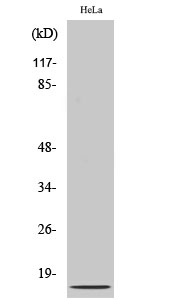
| WB | 咨询技术 | Human,Mouse,Rat |
| IF | 咨询技术 | Human,Mouse,Rat |
| IHC | 1/100-1/300 | Human,Mouse,Rat |
| ICC | 1/50-200 | Human,Mouse,Rat |
| FCM | 咨询技术 | Human,Mouse,Rat |
| Elisa | 1/20000 | Human,Mouse,Rat |
| Aliases | IL8; CXCL8; Interleukin-8; IL-8; C-X-C motif chemokine 8; Emoctakin; Granulocyte chemotactic protein 1; GCP-1; Monocyte-derived neutrophil chemotactic factor; MDNCF; Monocyte-derived neutrophil-activating peptide; MONAP; Neutrophil-activati |
| Entrez GeneID | 3576; |
| WB Predicted band size | 8kDa |
| Host/Isotype | Rabbit IgG |
| Antibody Type | Primary antibody |
| Storage | Store at 4°C short term. Aliquot and store at -20°C long term. Avoid freeze/thaw cycles. |
| Species Reactivity | Human |
| Immunogen | Synthesized peptide derived from the Internal region of human IL-8. |
| Formulation | Purified antibody in PBS with 0.05% sodium azide,0.5%BSA and 50% glycerol. |
+ +
以下是3-4条关于IL-8抗体的参考文献及其简要摘要内容:
---
1. **"A phase I study of a human monoclonal antibody to IL-8 (HuMab-10F8) in patients with metastatic solid tumors"**
*Berdel, W. et al. (2001)*
摘要:该I期临床试验评估了抗IL-8单抗(HuMab-10F8)在转移性实体瘤患者中的安全性和耐受性,发现抗体可抑制肿瘤相关炎症反应,部分患者病情稳定,提示IL-8阻断可能具有抗肿瘤潜力。
---
2. **"Targeting IL-8 signaling inhibits ovarian cancer progression"**
*Mabuchi, S. et al. (2016)*
摘要:研究证明抗IL-8抗体通过阻断IL-8/CXCR1/2信号通路,抑制卵巢癌细胞增殖、侵袭和血管生成,并在小鼠模型中显著增强化疗效果,为卵巢癌治疗提供新策略。
---
3. **"Serum IL-8 as a prognostic biomarker in cancer immunotherapy"**
*Sanmamed, M.F. et al. (2017)*
摘要:该综述探讨IL-8在肿瘤微环境中的作用,提出血清IL-8水平可作为免疫治疗(如PD-1/PD-L1抑制剂)的预后标志物,并强调抗IL-8抗体可能逆转免疫抑制微环境。
---
4. **"Structural basis of IL-8 recognition by therapeutic antibodies"**
*Zhou, T. et al. (2020)*
摘要:通过冷冻电镜解析抗IL-8抗体与IL-8蛋白的复合物结构,揭示抗体结合表位及阻断IL-8与受体CXCR1/2结合的分子机制,为优化抗体药物设计提供依据。
---
以上文献涵盖临床研究、机制探索及结构生物学领域,反映了IL-8抗体在肿瘤治疗中的潜在应用。
Interleukin-8 (IL-8), a member of the CXC chemokine family, is a pro-inflammatory cytokine primarily involved in recruiting neutrophils to sites of inflammation. It is produced by various cells, including macrophages, epithelial cells, and endothelial cells, in response to pathogens, tissue damage, or inflammatory stimuli. IL-8 exerts its effects by binding to G protein-coupled receptors CXCR1 and CXCR2. triggering signaling pathways that promote chemotaxis, angiogenesis, and cell proliferation. Dysregulated IL-8 expression is linked to chronic inflammatory diseases, cancer progression, and autoimmune disorders.
IL-8 antibodies are tools or therapeutics designed to neutralize IL-8 activity. In research, they are used to block IL-8 signaling in vitro and in vivo, helping elucidate its role in disease mechanisms. Therapeutically, IL-8-targeting antibodies aim to suppress excessive inflammation or tumor growth. For example, in cancers like melanoma or pancreatic cancer, IL-8 inhibition may reduce tumor-associated angiogenesis and metastasis. Clinical trials have explored IL-8 antibodies for conditions such as psoriasis, COPD, and COVID-19-related cytokine storms. Challenges include IL-8's functional redundancy with other chemokines and potential off-target effects. Both monoclonal and polyclonal IL-8 antibodies are utilized, with engineered variants (e.g., humanized antibodies) improving specificity and therapeutic potential.
×